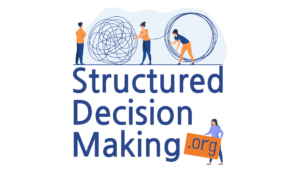Objectives Hierarchies
In most decision problems it will be useful to develop an objectives hierarchy to group similar objectives.
It’s important to be clear with this term that we do not mean to imply that that any one objective is somehow more or less important or higher in the hierarchy than another. These kinds of considerations come much later in the process. An objectives hierarchy simply provides some structure by grouping objectives of a similar nature. For example, a recent recovery plan for whooping cranes organized some of its objectives like this:
Aransas-Wood Buffalo population (AWBP) outcomes
- Maximize population size
- Minimize human disturbance
Captive population (SSP) outcomes
- Maximize population size
- Improve age structure
The order of presentation of these objectives is arbitrary – the AWBP outcomes could have come before the SSP ones with no change in meaning or implication.
A good way to develop objective hierarchies is by starting with a list of draft objectives and continually asking “what do you mean by that?”
Consider for example, a park planning exercise in which the fundamental objectives are defined as: “Protect Wildlife”, “Maximize Recreational Opportunities” and “Minimize Net Cost”. Asking “what do you mean by that?” may lead you to several sub-objectives that further describe exactly what is meant by these terms in this particular decision context.
In the following example, continuing the example of a recovery planning process for whooping cranes, the sub-objectives under each decision objective, taken together, describe everything that matters about the higher level decision objective. The performance measure is the specific metric that will be modeled and used to describe the performance of the management alternatives under consideration.
Decision Objective |
Sub-objective |
Performance measures |
| Aransas-Wood Buffalo population (AWBP) outcomes | Maximize population size | Total population size @ year 25 |
| Minimize human disturbance | Degree of disturbance (constructed scale) | |
| Captive population (SSP) outcomes | Maximize population size | Total population size @ year 25 |
| Improve age structure | # of reproductively mature birds | |
| Reintroduced population outcomes | Eastern Migratory Population (EMP) | Extinction probability @ year 25 |
| Louisiana Non-Migratory Population (LNMP) | Extinction probability @ year 25 | |
| Range-wide outcomes | Minimize time to AWBP down-listing criterion | Estimated year when down-listing Criterion 1B is reached |
| Expand breeding range | Assumed likelihood of range expansion (Constructed scale: 1=Yes, 0=No) | |
| Knowledge outcomes | Maximize learning | Learning potential (Constructed scale: 1=lowest learning potential, 5=highest) |
| Economic outcomes | Minimize cost | CAD $ Million |

